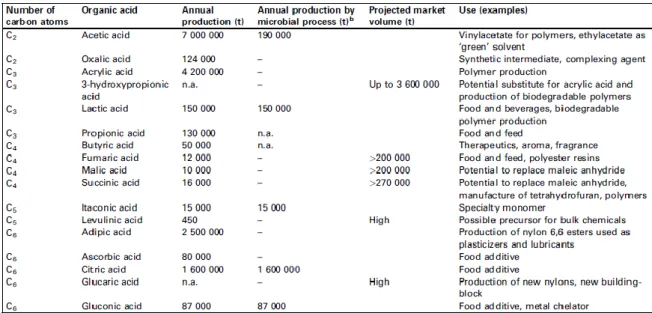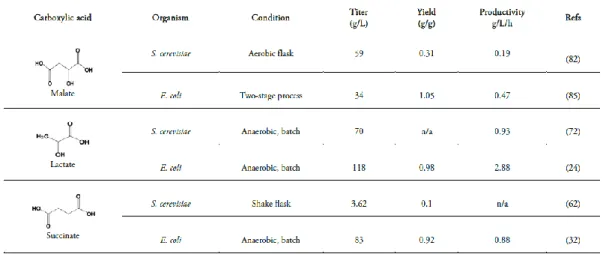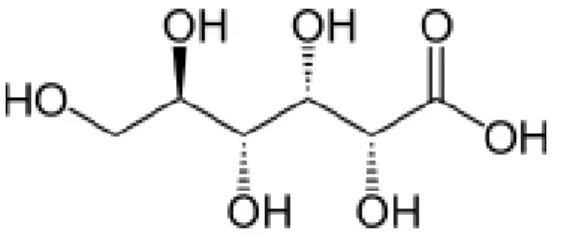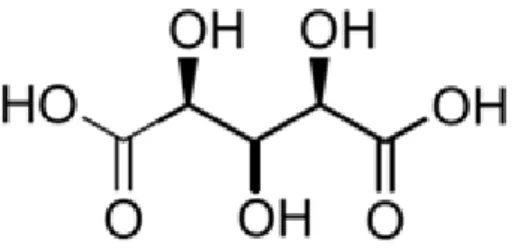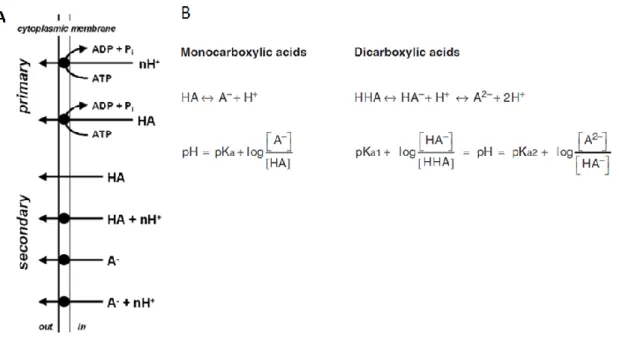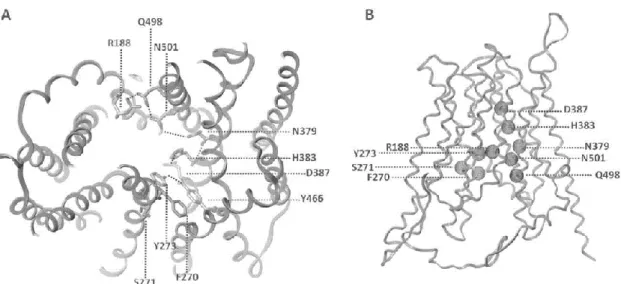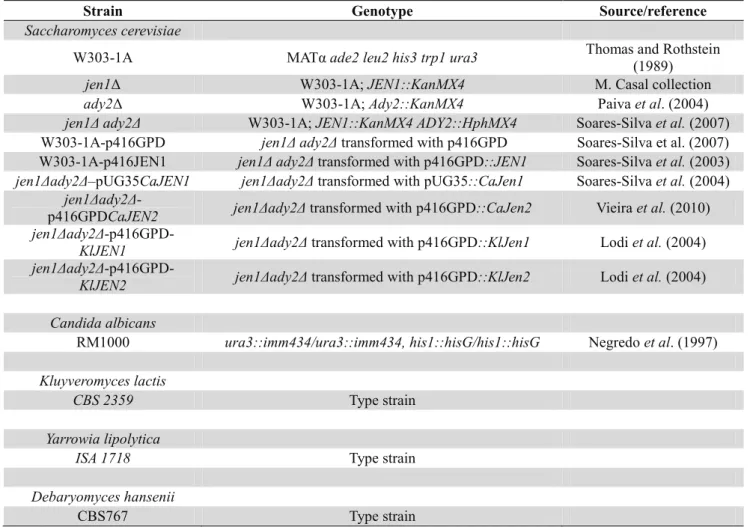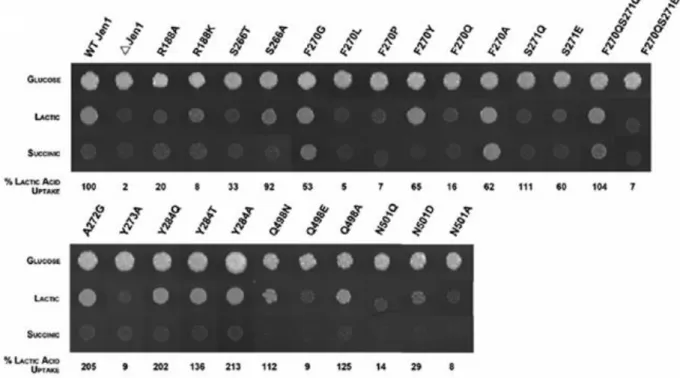David Manuel Nogueira Ribas
October, 2013
Structural-functional studies of carboxylic
acid transporters: novel tools in production
optimization using industrial microbes
UMinho|20
13
Da
vid Manuel Nogueir
a Ribas
Structural-functional s
tudies of carbo
xy
lic acid transpor
ter
s: no
vel tools in production op
timization using indus
trial microbes
Universidade do Minho
Escola de Ciências
David Manuel Nogueira Ribas
October, 2013
Master Thesis
Master in Molecular Genetics
Structural-functional studies of carboxylic
acid transporters: novel tools in production
optimization using industrial microbes
Universidade do Minho
Escola de Ciências
Work done under supervision of
Professora Doutora Margarida Casal
Professora Doutora Sandra Paiva
iii
DECLARAÇÃO
Nome: David Manuel Nogueira Ribas
Endereço eletrónico: ribas.david20@gmail.com Número do bilhete de identidade: 13254792
Título da tese: Structural-functional studies of carboxylic acid transporters: novel tools
in production optimization using industrial microbes
Orientadores:
Prof. Doutora Margarida Casal Prof. Doutora Sandra Paiva
Ano de conclusão: 2013
Designação do mestrado: Genética Molecular
DE ACORDO COM A LEGISLAÇÃO EM VIGOR, NÃO É PERMITIDA A REPRODUÇÃO DE QUALQUER PARTE DESTA TESE/TRABALHO
Universidade do Minho:__/__/__
iv
ACKNOWLEDGMENTS/AGRADECIMENTOS
À Professora Doutora Margarida Casal agradeço toda a confiança depositada em mim e a fantástica oportunidade de iniciar um projeto de investigação com um potencial enorme na minha área de formação, acrescendo o facto de ser gerido em parceria internacional com um instituto de investigação de conhecida reputação. Agradeço também a aposta na minha formação e no meu currículo e da qual me orgulho muito, assim como toda a ajuda e compreensão prestada ao longo de todo o mestrado. Eternamente grato.
À Professora Doutora Sandra Paiva agradeço toda a ajuda e acompanhamento que me prestou, em particular a aposta na minha formação. Agradeço também a ajuda preciosa na parte final da dissertação da tese. Obrigado por tudo
À doutora Joana Sá-Pessoa a forma como me recebeu e acompanhou ao longo de todo o mestrado, a confiança que depositou em mim, todos os conhecimentos que me transmitiu e toda a ajuda e apoio que me prestou. Agradeço também a aposta no meu currículo como investigador. A dedicação e perseverança na forma como faz ciência são uma referência para mim. Obrigado por tudo.
Aos colegas do Laboratório de Biotecnologia Molecular da Universidade do Minho agradeço a forma como me integraram no grupo e ajudaram ao longo de todo o projeto de investigação. É um orgulho ter pertencido a este grupo de pessoas e cientistas. Obrigado por tudo.
Ao Centro de Biotecnologia Molecular e Ambiental e ao “VTT Research Institute” agradeço todos os recursos disponibilizados.
v
ABSTRACT
Structural-functional studies of carboxylic acid transporters: novel tools in production optimization using industrial microbes
The rising global energy demands in last century drive to worrying depletion levels of fossil fuels, leading to a growing interest in microbial biofuel synthesis, particularly in model organisms like Saccharomyces cerevisiae. The microbial conversion of sugars to biofuels is a promising technology, thus envisaging for more efficient metabolic pathways has been attempted. Indeed byproducts of biomass pretreatment processes and the biofuels themselves are often toxic at industrially-relevant levels., therefore efforts to
improve production yield by engineering efflux systems to overcome toxicity problems and secret inhibitory chemicals from the cell has been revealed as a crucial alternative. In this scope, the aim of the present work was to screen a wide range of promising membrane transporters for the transport of carboxylic acids, particularly for xylonic acid, mucic acid, saccharic acid, gluconic acid and xylaric acid in the yeast S. cerevisiae. During this study a considerable number of membrane proteins, known as carboxylic acid transporters from different yeasts species were screened and functionally characterized in regard to the transport of mono- and dicarboxylic acids with biotechnological application, such as xylonic and gluconic acids, and saccharic, mucic and xylaric acids, respectively. Among the transporters tested, we have found evidences for the transport of four carboxylic acids, mucic, xylaric, gluconic and saccharic acids with the following specificities: gluconic acid (Ki of 13.2 mM and 40.6 mM), xylaric acid (Ki of 27.6 mM), mucic acid (Ki of 32.9
mM) and saccharic acid (Ki of 24.1 mM and 24.7 mM). These results revealed to be very
promising for future work aiming at engineering proper microbial strains with increased ability to export biofuel acids to external medium.
vi
RESUMO
Estudos funcionais/estruturais de transportadores de ácidos carboxílicos: novas ferramentas para otimização da produção em microrganismos industriais.
A crescente procura de combustíveis fósseis a que se assistiu no último século levou a que se atingissem limites de exploração preocupantes, redirecionando a atenção para a síntese microbiana de biocombustíveis, em particular através organismo modelo
Saccharomices cerevisiae. A conversão microbiana de açúcares em biocombustíveis
tem-se revelado uma tecnologia promissora, pelo que novas tentativas de melhorar a eficiência das vias metabólicas envolvidas no processo de síntese têm sido testadas. Tanto os produtos resultantes do processamento de biomassa como os próprios biocombustíveis exercem regularmente um efeito tóxico na produção à escala industrial. Nesse sentido, importantes esforços têm sido levados a cabo para desenvolver novos sistemas de efluxo com o intuito de reduzir problemas de toxicidade e conduzir para o exterior da célula diferentes compostos químicos.
Neste contexto, o objetivo do presente trabalho é desvendar o potencial de diferentes transportadores de membrana para o transporte de ácidos carboxílicos em S. cerevisiae. Ao longo deste estudo, várias proteínas de membrana, conhecidas como transportadores de ácidos carboxílicos provenientes de diferentes espécies de leveduras foram testadas e caracterizadas funcionalmente no que respeita ao transporte de ácidos mono e dicarboxílicos com interesse biotecnológico, tais como ácidos xilónico e glucónico, e ácidos sacárico, mucico e xilárico, respetivamente. De entre os transportadores testados foram encontradas evidências para o transporte de quatro ácidos carboxílicos, a saber os ácidos mucico, xilárico, glucónico e sacárico com as respetivas especificidades: ácido glucónico (Ki de 13,2 mM e 40,6 mM), ácido xilárico (Ki de 27,6 mM), ácido mucico (Ki
de 32,9 mM) e ácido sacárico (de 24,1 mM e 24,7 mM). Estes resultados revelam-se bastante promissores para futuros estudos que envolvam a obtenção de estirpes microbianas com capacidade desenvolvida para excretar biocombustíveis.
vii
TABLE OF CONTENTS
Acknowledgements/Agradecimentos………..……..iv
Abstract………..…..v
Resumo………....vi
Abbreviations and symbols………..….IX List of publications………XI 1. Introduction……….……….…1
1.1 Carboxylic acids: general properties and nomenclature………..1
1.2 Carboxylic acids in industry………2
1.2.1 Carboxylic acids production in Escherichia coli……….….6
1.2.2 Carboxylic acids production in Saccharomyces cerevisiae………..8
1.3 Sugar acids bio-production………...10
1.3.1 Gluconic acid microbial production………10
1.3.2 Xylonic acid microbial production………..11
1.3.3 Saccharic acid microbial production………..12
1.3.4 Mucic acid microbial production………13
1.3.5 Xylaric acid microbial production………...14
1.4 Plasma membrane carboxylic acid transporters in S. cerevisiae………..14
1.4.1 ScJen1 transporter and homologues………..17
1.4.2 Ady2 transporter and homologues……….22
1.4.3 Carboxylic acids toxicity in S. cerevisiae……….24
1.4.4 Mechanisms to avoid a futile cycle of diffusional entry and active extrusion of organic acids………...25
1.5 Outline of the thesis………...25
2. Materials and methods………..27
2.1 Biological material……….………27
2.2 Yeast cells culture conditions………29
2.3 Transport assays………..…….….30
3. Results……….…32
3.1 Seeking for novel production pathways of sugar acids in S. cerevisiae………32
3.1.1 Screening a ScJen1p mutant collection for potential export properties of xylonic, mucic and saccharic acids………...32
viii 3.1.2 Screening Jen1p homologous proteins in different yeast strains for
potential export properties of carboxylic acids………...37
3.1.3 Accessing carboxylic acids export properties in S. cerevisiae strains expressing heterologously CaJen1, CaJen2, KlJen1 and KlJen2………..41
3.2 Comparative analysis of inhibition constant (Ki) between the carboxylic acid transporters………47 4. Discussion………..48 4.1 Final remarks………...48 4.2 Future Perspectives………...51 5. Bibliography………..……53 Appendix……….………...59
ix
ABBREVIATIONS AND ACRONYMS
AMPK - Adenosine Monophosphate-activated Protein Kinaseald – aldehyde dehydrogenase COOH – Carboxyl group dhaB – glycerol dehydratase DNA - Deoxyribonucleic acid
HCOOH – formic acid HP – Hidroypropanoic
HPA – Hydroxypropionaldehyde
IUPAC – International Union of Pure and Applied Chemistry
GFP – Green Fluorescence Protein
GRAS – Generally recognized as safe LDH – Lactate dehydrogenase
Kd - diffusion constant Ki - inhibition constant Km – affinity constant
kmobs – inhibitor’s km
MFS – Major Facilitator Superfamily ORF – Open Reading Frame
PfK - Phospho-fructokinase
PLA – Polylactic acid
pmf – Proton motive force
PP1 - Phosphoprotein phosphatase 1
R – Hydrocarbon group SHS – Sialate:H+ Symporter
SSS – Solute/ Sodium Symporter Family
TCDB - Transport Classification Database
TDT - Tellurite-resistance/Dicarboxylate Transporter
x
Vmax - maximum velocity
YNB – Yeast nitrogen base YP – yeast extract peptone
xi
FIGURES AND TABLES
Figure 1.1– Chemical structure of carboxylic acid group Figure 1.2– Molecular structure of Gluconic Acid Figure 1.3– Molecular structure of Xylonic acid Figure 1.4– Molecular structure Saccharic acid Figure 1.5 – Molecular structure of mucic acid Figure 1.6– Molecular structure of xylaric acid
Figure 1.7– A) Schematic overview of the mechanisms involved in weak organic acid
export via primary and secondary transport. B) The distribution between undissociated acid (HA or HHA) and dissociated anions (A-, HA- and A-2) and protons (top equations)
is determined by the pH of the environment and the pKa of the carboxylate groups as described in the equations
Figure 1.8 - Predicted topology of Jen1p, built by the TMHMM software
(http://www.cbs.dtu.dk/services/ TMHMM-2.0/), with the location of the identified motif highlighted. The protein topology shown is composed of 12 transmembrane helices and cytoplasmic N- and C-tails.
Figure 1.9 - Overall structure of the Jen1p model. A) A section of the transporter as
viewed from the periplasmic side. Visible is the spiral rim-like network of hydrogen bonds that is formed. B) Side view of the protein. Residues that define the translocation pathway are illustrated as spheres.
Figure 1.9 - Overall structure of the Jen1p model. A) A section of the transporter as
viewed from the periplasmic side. Visible is the spiral rim-like network of hydrogen bonds that is formed. B) Side view of the protein. Residues that define the translocation pathway are illustrated as spheres.
Figure 1.10- Phylogenetic tree of ScJen1p homologues. The sequences used were
obtained from Genolevures, except for the Pichia stipitis and Candida albicans homologues which were obtained by homology search with BLASTP (http://www.ncbi.nlm.nih.gov/blast/Blast.cgi). The permeases with characterized function are highlighted in bold.
Figure 2.1– p416GPD vector elements.
Figure 2.2– pDS1 (p416GPD::JEN1) vector elements
Figure 3.1- Growth test of control strains and mutants on glucose (2%), lactic acid (0.5%)
or succinic acid (1%). All strains are isogenic (S. cerevisiae W303-1A jen1Δ ady2Δ) expressing from a low copy plasmid either wild-type Jen1 (WT-Jen1) or the relevant
xii Figure 3.2. Relative capacity (%) of 14C-lactic acid uptake (60 mM), after 1 minute
incubation with non-labelled carboxylic acids (10 mM), at pH 5.0 and 30 ºC, acting as inhibitors for the transport of lactate in Jen1p mutants: A, A272G; B, F270G; C, F270A; D, F270QS271Q; E, Q498A; F, Y284Q; G, Y284A; H, Q386A; I, S271Q. The data shown are mean values of at least two independent experiments and the error bars represent standard deviation.
Figure 3.3- Eadie-Hoffstee plots of the initial uptake rates of 14C-lactic acid as a function
of the acid concentration at pH 5.0, 30 ºC for S. cerevisiae jen1Δ ady2Δ p416GPDJen1p-S271Q: ●, no inhibitor; in the presence of saccharic acid 20 mM (■) and 30 mM (▲).
Figure 3.4- Relative capacity (%) of radiolabelled carboxylic acid uptake, after 20
seconds incubation with non-labelled carboxylic acids (10 mM), at pH 5.0 and 30 ºC, acting as inhibitors for the transport in: A) D. hansenii (14C-succinic acid 20mM); B) D.
hansenii (14C-lactic acid uptake 60 mM); C) Y. lipolytica (14C-succinic acid 20mM); D) Y. lipolytica (14C-lactic acid uptake 60 mM); E) K. lactis (14C-succinic acid 20mM); F)
K.lactis (14C-lactic acid uptake 60 mM); G) C. albicans (14C-succinic acid 20mM); H) C. albicans (14C-lactic acid uptake 60 mM)
Figure 3.5- Relative capacity (%) of radiolabelled carboxylic acid ady2expressing in
trans distinct Jen1 C. albicans homologues. The cells were incubated during 1 minute
with non-labelled carboxylic acids (10 mM), at pH 5.0 and 30 ºC, acting as inhibitors of the labeled substrate. A) 14C-lactic acid uptake (60 M) in cells transformed with pUG35::CaJen1 plasmid. B) 14C-succinic acid uptake (20 M) in cells transformed with
p416GPD::CaJen2.
Figure 3.6- Eadie-Hoffstee plots of the initial uptake rates of 14C-succinic acid as a
function of the acid concentration at pH 5.0, 30 ºC. A) S. Jcerevisiae jen1Δ ady2Δ p416GPDCaJen2: ●, no inhibitor; in the presence of xylaric acid 20 mM (■) and 30 mM (▲). B) S. cerevisiaejen1Δ ady2Δ p416GPDCaJen2: ●, no inhibitor; in the presence of saccharic acid 20 mM (■); and 30 mM (▲). C) S. cerevisiae jen1Δ ady2Δ p416GPDCaJen2: ●, no inhibitor; in the presence of gluconic acid 20 mM (■) and 30 mM (▲).
Figure 3.7- Relative capacity (%) of radiolabelled carboxylic acid uptake after 1 minute
incubation with non-labelled carboxylic acids (10 mM), at pH 5.0 and 30 ºC, acting as competitors for the transport in strains expressing heterologously the carboxylate transporter. A) 14C-lactic acid uptake (60 M) in jen1Δ ady2Δ strain transformed with p416GPD::KlJen1; B) 14C-succinic acid (20 M) jen1Δ ady2Δ strain carrying p416GPD::KlJen2.
Figure 4.1- Overview of carboxylic acids transport properties found for CaJen2, KlJen2
and Jen1pS271Q membrane transporters
Table I – Market and current production processes of organic acids. Table II – Organinc acids market demands.
xiii Table III - Production of the carboxylic acids malate, lactate and succinate by E. coli and
S. cerevisiae from glucose.
Table IV – Yeast strains used in this work. Table V – Plasmids used in this work.
Table VI - Ki values (mM) for the sugar carboxylic acids transporters expressed in S. cerevisiae.
1
1. INTRODUCTION
1.1 Carboxylic acids: general properties and nomenclature
Carboxylic acids are organic compounds containing a carboxyl group (COOH) and a hydrocarbon group (R) (fig.1.1). These two unlike parts have great impact on the physical, as well as, chemical properties of the molecule as a whole (Abbott et al., 2009).
Carboxylic acids are easily converted into both esters and amides, and the esters and amides are also converted back to the carboxylic acids. These properties make molecules that contain carboxylic acids, amides, and esters important in biochemistry and chemical industry.
The most significant property of carboxylic acids is their behavior as weak acids. They surrender the hydrogen of the carboxyl group, COOH, to bases and establish acid base equilibrium in aqueous solution. The common carboxylic acids share the concentration-dependent corrosive properties of all acids but are not generally hazardous to human health. Like alcohols, carboxylic acids form hydrogen bonds with each other so that even formic acid (HCOOH), the simplest carboxylic acid, is a liquid at room temperature with a boiling point of 101 °C. Acids with saturated straight-chain, R groups, of up to nine carbon atoms are volatile liquids with strong, pungent, and usually unpleasant odors; those with up to four carbons are water-soluble. Acids with larger saturated R groups are waxy, odorless solids. Their water solubility falls off as the size of the hydrophobic, alkane R group increases relative to the size of the water-soluble portion (McMurry et al., 2010).
Figure 1.1– Chemical structure of carboxylic acid group (Chemspider, 2013).
Carboxylic acids are named in the International Union of Pure and Applied Chemistry (IUPAC) system by replacing the final -e of the corresponding alkane name with -oic
2
acid. Thus, the names corresponding to the one-, two-, and three-carbon acids are
methanoic acid, ethanoic acid, and propanoic acid. These names are derived from methane, ethane, and propane. If alkyl substituents or other functional groups are present, the chain is numbered beginning at the end, as in 3-methylbutanoic acid or in 2-hydroxypropanoic acid, which is better known as lactic acid, the acid present in sour milk. Dicarboxylic acids, which contain two carboxylic groups, are named systematically by adding the ending -dioic acid to the alkane name (the -e is retained). Unsaturated acids are named systematically in the IUPAC system with the ending –enoic (McMurry et al., 2010).
The IUPAC method is neither the only nor the most-used method for naming acids, primarily because carboxylic acids were among the first organic compounds to be isolated and purified. Organic acids are usually known by common names. Methanoic, ethanoic, and propanoic acids are called formic, acetic, and propionic acids, respectively. These names often refer to a natural source of the acid and are not systematic. Many of the carboxylic acids, especially those with even numbers of carbon atoms ranging from 4 to about 20, exist in combined form in plant and animal fats. These are called fatty acids. Another nomenclature method uses letters of the Greek alphabet (α, β, γ, δ,…) to name certain acid derivatives, especially hydroxy, amino, and halogen acids. When Greek letters are used, the carbon atoms, beginning with the one adjacent to the carboxyl group, are labeled α, β, γ, δ. When numbers are used (the IUPAC System), the numbers begin with the carbon in the COOH group (McMurry et al., 2010).
1.2 Carboxylic acids in industry
Carboxylic acids together with enols, phenols, sulfonic acids, mercapto-compounds, and phosphonic acids make up the organic acids group. During centuries they have taken an important role in human development. Their presence goes from ancient to modern foods and beverages, as well as drugs, detergents, cosmetics, polymers, plastics, resins, and many other biochemical or chemical products (Huang et al., 2007).
There are two main industrial approaches for the production of organic acids: fermentation and chemical synthesis. Fermentation processes were dominant in the production of organic acids from the end of the nineteenth century until the beginnings of the last century. The main precursor for such monopoly leans on Pasteur’s microbiological founds, mainly due to the abolishment of spontaneous generation theory
3
and the identification of fermentative microorganisms. However, the petrochemical industry revolution, boosted by the first and second world wars in the first half of the late century unveils new chemical synthesis procedures highly competitive, driving the organic acid market until the 90’s. Raising concerns about sustainable development and human health safety gave a new opportunity to fermentative industry. With the recombinant DNA (Deoxyribonucleic acid) technology revolution in the last two decades, virtually all organic acids can be produced by microorganisms, unlike chemical synthesis. Meanwhile, the products from fermentation have a higher safety degree, which is a significant advantage to human health. Another advantage of microbial production is the high specificity for production of desirable stereospecific forms of carboxylic acids (Hong and Nielsen, 2012; Huang et al., 2007).
Whether it is fermentation or chemical synthesis, separation, concentration, and purification are necessary for product preparation. More downstream processes are required by fermentation since the carboxylic acid is recovered from culture broth. The related traditional techniques include precipitation and acidification, extraction, crystallization, distillation, ion-exchange, and adsorption. Precipitation and acidification are perhaps the most unfriendly processes to environment, due to solid pollution, particularly by gypsum. Solvent extraction is handicapped by undesirable distribution coefficients and environmental problems due to the use of hazardous solvents. Crystallization is unfavorable due to its low yield, high costs for chemical use, and waste discharge (Sauer et al., 2008).
Currently, carboxylic acids building blocks for biofuels can be obtained via microorganism’s fermentative properties, and represent a reliable replacement to petroleum-based fuels (Table I). Producing these biofuels in a cost effective manner often requires the engineering of cell’s machinery (Peralta-Yahya et al., 2012).
4 Table I – Market and current production processes of organic acids (Almeida et al.,
2012).
Usually biofuel production from microorganisms’ metabolism uses as a main nutrient food crops (mainly starch and sucrose), however a danger linkage between fuel and food prices is established. Therefore alternative and cheaper nutrient sources, such as algae biomass, greenhouse gases, lignocellulose and carbon dioxide are preferred. Algae biomass grows in salt water rather than arable land, but its collection and dewatering is challenging. Lignocellulose is a rich source of sugars and highly abundant, however thermal, chemical and biochemical pretreatment are needed for sugar polymers hydrolysis. Through photosynthetic organisms carbon dioxide could be transformed in biofuels (Hong and Nielsen, 2012).
Microbial production is not only related with engineering the selected host and the choice of nutrient source but also factors as energy content, combustion, engine type, quality or ignition delay, cloud point, volatility, lubricity, viscosity, stability, odor, toxicity, water miscibility must be considered (Peralta-Yahya et al., 2012)
In the last decade, several reports from international institutions, such as The United States Department of Energy, the European Group BREW and the European Commission have emphasized the potential of carboxylic acids as key players in enzymatic and chemical catalysis processes (Table II). On the other hand several studies have also shown that the potential of organic acids has been underestimated. Most of the microbial production of these platform chemicals is targeted to food applications and at the moment
5
it comprises a modest market size, however its huge potential holds a staggering future (Abbott et al., 2009).
Table II – Organinc acids market demands (Sauer et al., 2008).
In this context, the native potential for carboxylic acid production by microorganisms should be engineered and boosted in order to strive with petrochemical production, which is a well-established, productive and robust industry. In order to attain such productive and effective microbes, strain improvement is the most elected approach for such propose. First attempts for microbial strain improvement were based in “classical genetics” by induction of random mutagenesis associated to advanced selection analysis of mutants with higher performance. Indeed, “classical genetics” approach is a well-established tool for the biotechnology industry, but further tools such as recombinant DNA technology and metabolic engineering are required and should be a complementary part of the previous one, allowing manipulation of regulatory, transport and enzymatic functions of the cell (Liu and Jarboe, 2012).
Nowadays, many carboxylic acids are preferentially produced by prokaryotic organisms. However, most of these prokaryotes, such as lactic-acid bacteria have complex nutritional requirements because of reduced ability to synthesize B-type vitamins and amino acids, representing an increased cost, as well as more difficult downstream processing (Wee et
6
organic acids at the low pH values where these acids are present in their undissociated form. As a solution, acid-tolerant microorganisms, such as the yeast Saccharomyces
cerevisiae with higher predisposition for growing at lower pH conditions, would reduce
the cost for pH titrants and limiting byproduct formation (e.g. gypsum). Additionally, several species of filamentous fungi are known to naturally produce high amounts of carboxylic acids, such as Aspergillus niger, which is applied for large-scale citric acid production (Papagianni, 2007), and Aspergillus flavus, which natively produces high quantities of malic acid (Battat et al., 1991). However, the morphology structure of these fungi holds a barrier for growth and production tuning. The production of aflotoxins, in the case of A. flavus also contributes to additional problems in process and product safety (Abbott et al., 2009). A comparison between the titers values of the main carboxylic acids obtained by microbial production of E. coli and S. cerevisiae is presented in table III. In this introduction chapter will be reviewed in more detail the production of carboxylic acids by S. cerevisiae and E. coli, two important model microorganisms with high potential for the biotechnology industry.
Table III - Production of the carboxylic acids malate, lactate and succinate by E. coli and
S. cerevisiae from glucose (Liu and Jarboe, 2012).
1.2.1 Carboxylic acid production in Escherichia coli
Among the most widely used biocatalysts, E. coli, a gram-negative bacteria, has been explored in different biotechnological processes. This microorganism has several advantages in relation with other cell factories, namely: many feasible genetic tools, which have been developed in the last 30 years; its sensitivity to many antibiotics, which is extremely useful for strain selection and screening; a clear integrome information
7
facilitating metabolic engineering approaches; a deep knowledge of central carbon metabolism and physiology; it grows fast in minimal media and keeps the ability to metabolize both 5 and 6 carbon sugars (van Maris et al., 2004).
Genetic and metabolic engineering, directed evolution, and classic strain selection have been used in the improvement of E. coli strains that produce organic acids building blocks, such as succinic acid, lactic-acid and 3-hidroypropanoic acid (3-HP). Improved titers have been reached by optimization of fermentation conditions and new biological pathways. However, titer limitations occur when fermentation is processed in unbuffered media, allowing acidification phenomena related with raising acid concentration. On the other hand, considerable quantities of base titrant could be used to alkalinize media during the organic acid production and subsequently the anion form of carboxylic acid would prevail. As an approach to solve this bottleneck, metabolic and genetic engineering tools are being employed in order to develop acid tolerance strains, turning fermentation possible at a pH below pKa of the acid produced, reducing the costs with acid and base titrants (Mills et al., 2009; Warnecke and Gill, 2005).
One of the most successful examples of large volume chemical production in E. coli is lactic acid production. Relying in pentose and hexose consumption, E. coli was selected as a favorable host strain to produce optically pure L-lactic acid, which is the ultimate desired precursor for chemical synthesis of polylactic acid (PLA). Through heterologous expression of the L-specific lactic acid dehydrogenase (LDH) gene from Streptococcus
bovis, a lactic acid producing strain of E. coli was created (Wyckoff et al., 1997). Under
anaerobic and pH buffered conditions (pH 7.0), high titers (50–75 g/L) were observed, but if pH was allowed to drop with increasing acid production, titers fall to 10–20 g/L (Wyckoff et al., 1997). However, it should be mentioned that in the last approach the undissociated form was predominant (pH < pKa), decreasing the costs of downstream processes. The strain genetic´s background - mainly associated with growth features - also determines lactic acid production efficiency, as for instance E. coli K12 selected strains get the equivalent to half production of E. coli B strains (van Maris et al., 2004; Warnecke and Gill, 2005).
Interesting titers of succinic acid have been collected from E. coli fermentation broth. E.
coli strains were genetically engineered in order to tune their metabolism for succinic acid
biosynthetic pathways, avoiding the production of other anaerobic byproducts. Therefore, succinic acid production was increased due the inactivation of the pyruvate-formatelyase and lactate dehydrogenase, impairing the conversion of pyruvate into lactate and formate.
8
As described for lactic acid production, in pH controlled conditions, titers obtained (50 g/L) were significantly higher than pH unbuffered cultures (Yu et al., 2011).
At last, another metabolic engineered E. coli for 3HP production was reported. kumar et al. (2013) reported a 2-step pathway, where glycerol was the preferred precursor to be converted in 3HPA (3-hydroxypropionaldehyde) and then in 3HP through a catalysis reaction performed by glycerol dehydratase enzyme (dhaB – isolated from Klebsiella
pneumoniae) and aldehyde dehydrogenase (ald). However very diminished titers (0.2
g/L) were reported (van Maris et al., 2004). Thus, five additional pathways were proposed by Selifinova et al. relying in 3-HP production directly from glucose, but until the moment no experimental data was reported regarding this new approach. One bottleneck that remains to be solved is the need to produce 3HP at a pH value below the pKa = 4.51 of 3HP, which would decrease the dependency on large amounts of base titrant to retain neutral pH at high titers (Yu et al., 2011).
As discussed previously, different range of tools and biological machinery for carboxylic acid production are available in E. coli. However issues regarding organic acid anion toxicity deserve attention for future genetic engineering efforts to circumvent tolerance against the less well characterized metabolic effects associated with increased organic acid anion concentrations (Warnecke and Gill, 2005).
1.2.2 Carboxylic acid production in Saccharomyces cerevisiae
The low performance of S. cerevisiae to produce organic acids in large quantities through their own machinery is well known, however features like pH tolerance, robustness, simple nutrient requirements and a huge repertoire as an industrial workhorse turns this exceptional living organism to one of the most perfect candidate for such processes. A fundamental approach to increment carboxylic acids production by S. cerevisiae is leaned in the flux reduction of ethanol fermentation by artificial evolution, genetic engineering and selection in order to increase the concentration of pyruvate, a critical precursor molecule for organic acid synthesis. Complementary manipulation, such as expression of heterologous enzymes and transporters could boost strain production, specifically for lactate and malate production (Abbott et al., 2009).
From centuries ago, S. cerevisiae has been used unconscionably in the production of traditional foods and beverages, such as cheese, bread, beer and wine. However after the
9
industrial revolution its potential was employed in different industrial processes, either in new food manufacture or for metabolite production, covering a high range of applications (Donalies et al., 2008). Interestingly, most of these processes still rely on both wild-type or strains from classical genetics improvement. In the last decade, researchers´ efforts were focused in meliorate S. cerevisiae for the production of organic acids from lignocellulosic and at the same time maintaining its efficiency and robustness. (Hong and Nielsen, 2012; Steen et al., 2008).
Regarding the production of simple carboxylic acids, at the moment there are no reports of industrial application of S. cerevisiae. However this organism holds a particular ability to grow extremely well under acidic conditions even at pH values below 3.0, making it a preferred target. The great majority of weak acids (e.g succinate (pKa = 4.21, 5.67), lactate (pKa = 3.86) and malate (pKa = 3.41, 5.05)) at such pH tend to occur in their undissociated form, avoiding the expensive steps of alkali agents addition during fermentation and acidifying process after fermentation. Thus it allows the direct collection of undissociated form demanded by costumers. Moreover, the bread yeast is well adapted to survive in simple chemically defined media, which make the production and downstream processing cheaper. At last, S. cerevisiae is recognized as a GRAS (Generally Recognized As Safe) organism, which gives a crucial advantage for production of carboxylic acids applied to medical and food applications (Piper et al., 2001).
New approaches have been developed to improve S. cerevisiae cells’ ability to produce monocarboxylic acids, namely pyruvate and lactate, as well as dicarboxylic acids, namely malate and succinate - natural metabolites resulting from glucose oxidation but poorly excreted to the extracellular medium. These approaches comprise different levels of action: elimination of alcoholic fermentation, which, irrespective of the availability of oxygen, is the major route of sugar dissimilation in batch cultures of wild-type strains (Abbott et al., 2009); engineering fast and efficient metabolic pathways that link the high-capacity glycolytic pathway with the product of choice, taking into account redox and free-energy constraints; engineering of product export; engineering of product, substrate and/or environment tolerance. All these concepts and developments will also be important tools for S. cerevisiae as a platform for the production of carboxylic acids.(Abbott et al., 2009; Liu and Jarboe, 2012).
10 1.3 Sugar acids bio-production
Sugar acids are currently generating considerable interest due to their potential as platform chemicals and precursors in the manufacture of biomass derived plastics. Their microbial production is getting important attention as a guaranteed sustainable production process of these sugar acids (Toivari et al., 2012b).
Regarding sugar acids, the state of art for microbial production of gluconic, xylonic, xylaric, saccharic and mucic acids will be emphasized.
1.3.1 Gluconic acid microbial production
The Gluconic monocarboxylic acid (Fig. 1.2), also known as pentahydroxycaproic acid is obtained from glucose oxidation. Although this process could be fully conducted by chemical synthesis, fermentation is preferred for industrial scale production. Through metabolism the hexose sugar suffers enzymatic conversion, by glucose oxidase, of the aldheide group in the first carbon to a carboxyl group resulting in glucono-δ-lactone. Then this molecule is hydrolyzed spontaneously or via peroxidase catalysis having as final product gluconic acid (Anastassiadis and Rehm, 2006).
Gluconic acid production dates back to 1922 when this sugar was found in the fermentation broth of Aspergillus niger. After that new microorganisms were used for gluconic acid production such as Pseudomonas, Gluconobacter and Acetobacter bacteria, as well as Penicillium fungi. The fermentation process was found highly pH-dependent and addition of calcium carbonate results in increased yield (Ramachandra, et al. 2008). Presently, gluconic acid industrial production is leaned in A. niger fed-batch fermentation, at buffered pH around 6.0 – 6.5 and 34º C. After purification, the final product sodium gluconate reaches concentrations around 360 g/L considering a 24 h fermentation time (Ramachandran et al., 2008).
Gluconic acid is used in wide range of industrial fields. In food industry, this weak acid is used as flavoring and leavening agent, fat absorption intervenient and mineral supplement. It is used in textile industry to prevent polyamide and polyester desizing and iron deposition. Due to its chelating properties it has several applications in metallurgy industry, concrete resistance and mouthwashes products. The zinc gluconate salt is used in common cold treatment, wound healing and in several diseases caused by zinc
11
deficiencies, such as mental lethargies, skin changes, delayed sexual maturation and immunodeficiency (Ahuja et al., 2007; Biagi et al., 2006; Erzinger and Vitolo, 2006).
Figure 1.2– Molecular structure of Gluconic Acid (Chemspider, 2013).
1.3.2 Xylonic acid microbial production
D- Xylonic acid (Fig. 1.3) is a monocarboxylic acid produced from D-xylose oxidation. Such process can be addressed by fermentative, chemical and enzymatic processes. Regarding fermentative process, it is carried out by both D-xylose and D-glucose dehydrogenases with a corresponding xylonolactone, which is converted into D-xylonate spontaneously or via lactonase (Toivari et al., 2012a; Toivari et al., 2012b). In 1898 fermentative production of xylonic acid was reported for the first time. Since then several different bacteria were described as xylonate producers such as Pseudomonas sp.,
Acetobacter sp., Aerobacter sp., Gluconobacter sp. and Erwinia sp., as well as other fungi
species, particularly Aspergillus niger. In addition, and quite recently, E. coli and some yeast strains, including S. cerevisiae, were successfully metabolic engineered for the production of D-xylonate, through the introduction of heterologous D-xylose dehydrogenase genes (Toivari et al., 2010).
Due to structural likeness xylonic acid is recognized as a proper substitute of gluconic acid and thus it has a wide spectrum of applications, among which production of copolyamides, precursor for 1,2,4-butanetriol synthesis and dispersal of concrete. However and unlike gluconic acid, xylonic acid could be biotechnological produced from non-food carbohydrate (Toivari et al., 2012a).
12 Figure 1.3– Molecular structure of Xylonic acid (Chemspider, 2013).
1.3.3 Saccharic acid microbial production
Saccharic acid (Fig. 1.4), also known as glucaric acid, is a dicarboxylic acid commonly found in vegetables, fruits and mammals. Since 1888, saccharic acid chemical synthesis production is processed in a very expendable way by nitric acid oxidation of D-glucose and recovered as potassium salt. Meanwhile other chemical versions of this process were created in order to increase the range of applications (Denton et al., 2011).
Despite the inexistence of microbial production reports at industrial scale, strong efforts have been made to change this scenario. Recently a metabolic engineering approach to glucaric acid production by E. coli was reported. For that, the D-glucuronic acid pathway of mammals, which converts D-glucose in D-saccharic acid after a ten enzymatic step conversion, served as basis to achieve it. However this is a quite long pathway and very difficult to mimic in E. coli, so it was zipped. The insertion of three genes of distinct organism was required: INO1 from S. cerevisiae gene codifying for myo-Inositol- 1-phosphate synthase; Miox mice gene for expression of myo-inositol oxygenase and udh from Pseudomonas syringae encoding for uronate dehydrogenase. Yields of 1 g/L of saccharic acid were obtained. Further developments will be needed to get a feasible microbial production of this carboxylic acid, but the first results are encouraging (Moon
et al., 2009).
Among the more demanded saccharic acid applications are medical applications for induction of cholesterol reduction and cancer chemotherapy; chemical platform for polymer production, such as nylon, polyesters and biodegradable fibers (Denton et al., 2011; Moon et al, 2009; Yu et al., 2011).
13 Figure 1.4– Molecular structure Saccharic acid (Chemspider, 2013).
1.3.4 Mucic acid microbial production
Mucic acid or galactaric acid (Fig. 1.5) is a dicarboxylic acid commercially produced by two alternative methods: D-galactose oxidation with nitric acid or electrolytic oxidation of D-galacturonate. At the moment there are no reports of commercial microbial production of mucic acid (Sengoku et al., 2012). However, a new engineered metabolic pathway was reported recently in two filamentous fungi for the production of galactarate from D-galacturonate, a compound of pectin and easily assimilated by these microorganisms. The first step operated was the deletion of genes encoding D-galacturonate reductase, gar1 and gaaA of Hypocrea jecorina and A. niger, respectively. The deletion of these genes impairs the reduction of D-galacturonate and its conversion in undesirable metabolites. Subsequently, the two fungi were transformed with udh gene from Agrobaterium tumefaciens. This gene encodes a D-galacturonate dehydrogenase, responsible for oxidation of D-galacturonate in D-galactarolactone, which is spontaneously hydrolyzed in galactarate (mucate). When mucic acid production was assessed, H. jecorina revealed better production performance than A. niger, approximately 5.9 g/L against 1 g/L of mucate, respectively. Such reduced production levels in A. niger should be associated with galactarate catabolism after its formation. However, while in A. niger mucate titers are almost the same intracellularly and extracellularly, H. jecorina has higher accumulation in cytoplasm than culture media. Here, the media pH associated with proper transport systems are crucial in extracellular accumulation of mucic acid. In fact, higher titers of external mucate were measured when the two filamentous fungi were grown in neutral pH rather than acidic broth. Due to its low solubility, galactaric acid is easily purified (Mojzita et al., 2010).
14
Mucic acid has been used as chelator agent, in skin care products, as a leavening agent, as well as a platform chemical and in polymer synthesis (Mojzita et al., 2010; Sengoku
et al., 2012)
Figure 1.5 – Molecular structure of mucic acid (Chemspider, 2013).
1.3.5 Xylaric acid microbial production
Xylaric acid (fig. 1.6) is a dicarboxylic acid chemically synthetized by nitric acid oxidation of D-xylose or alternatively 5-ketogluconic acid oxidation (Sergienko et al., 2010). At the moment there are no reports about microbial production of xylaric acid. This hidrocarboxylic acid is known as a precursor of heterometallic, oxide, and porous materials. In addition derivatives of xylaric acid, such as metal complexes, have shown interesting biological properties. In vitro assays reported anticancer activity and toxic effect against tumor cells by this class of compounds (Sergienko et al., 2010).
Figure 1.6– Molecular structure of xylaric acid (Chemspider, 2013).
1.4 Plasma membrane carboxylic acid permeases in Saccharomyces cerevisiae
The first evidence for a carboxylic acid membrane transporter in yeasts was found in
15
the permease associated with the transport of malic, maleic, oxaloacetic, malonic, succinic and fumaric acids (Grobler et al., 1995).
The first work reporting a monocarboxylate transport system was published in Candida
utilis (Leão and Van Uden, 1986) and an identical transporter was also reported in S. cerevisiae (Cássio et al. 1987). In both cases cells grown in lactate revealed activity for
an accumulative proton-monocarboxylate symporter, with affinity for L and D-lactate, pyruvate, propionate and acetate and subjected to glucose repression.
Another monocarboxylate transporter was identified in S. cerevisiae growing in ethanol or acetate, however, and unlike the previous one, it has only specificity for propionate, acetate and formate (Casal et al., 1996). Others permeases were identified in yeast species such as Torulaspora delbrueckii, Zigosaccharomyces bailii and Dekkera anomala (for review see Casal et al., 2008). It is also noteworthy, the report of a distinct monocarboxylate uniporter identified on K. marxianus (Casal et al., 2008; Queiros et al., 2007).
Yeast cells establish an electrochemical gradient through their biological membranes. As the name mentions, this gradient comprises a pH gradient and an electrical potential difference, with the inside of the cell (cytoplasm) alkaline and negatively charged relatively to the outside. The transport of protons or cationic particles and anions make up the proton motive force (pmf), which will provide energy for cells´ activity. These net translocations are mediated by cells´ machinery, such as proton-pumping ATPases, solute export systems and respiration-driven proton translocation (Fig. 1.7) (Casal et al., 2008). A strictly coordinated regulation is then applied by microorganisms, reacting spontaneously to every extracellular pH change in order to maintain their internal homeostasis, usually at neutral values. The pmf is also maintained constant across the cell plasma membrane, even in acidophilic bacteria like Thermoplasma acidophilum and Picrophilus oshimae exposed at different pH deviations. At very low pH conditions the
intracellular compartment can become positive (+120 mV) (van Maris et al., 2004). At intracellular pH values ranging from 6.0 to 8.0 carboxylic acids are predominantly in the anion or dissociated form according to the equation pH = pKa + log (A-/HA), passive
diffusion of these solutes is dependent on their solubility and their permeability across the membrane. Therefore, only specific transport proteins in the membrane allow export of this weak acid form.
When microorganisms redirect their metabolism to weak acid production, the pH homeostasis is maintained by the export of the undissociated and dissociated (more
16
predominant) acid forms. This export can be achieved in two, energetically equivalent, ways: (1) uniport of the undissociated acid, or (2) symport of the anion with a proton. To maintain electroneutrality and intracellular pH homeostasis, anions and protons do not need necessarily to be transported by the same transporter. Thus, when the anions are exported via a uniport system, the resulting surplus protons can be excreted via proton-pumping ATPases. On the other hand, when secondary transport is coupled to the export of additional protons, the resulting pmf has to be used for pmf-driven processes, such as the generation of ATP by ATPase (Casal et al., 2008; Stratford et al., 2013; van Maris et
al., 2004).
Yet all these principles are specifically applied to carboxylates transport. However further attention is needed once export energetics could diverge from the previous one. Regarding the uniport of the monovalent anion it follows the same energetic balance of the anion form of monocarboxylic acids. However, the divalent anion transport by primary or secondary transporters implies the additional transport of the remaining proton by proton-pumping ATPases in order to maintain the electrochemical gradient (Abbott et al., 2009).
Figure 1.7– A) Schematic overview of the mechanisms involved in weak organic acid
export via primary and secondary transport. B) The distribution between undissociated acid (HA or HHA) and dissociated anions (A-, HA- and A-2) and protons (top equations)
is determined by the pH of the environment and the pKa of the carboxylate groups as described in the equations. Adapted from Abbot et al., 2009; Maris et al., 2004.
17 1.4.1 ScJen1 transporter and homologues
The S. cerevisiae JEN1 was the first gene found to be related with transport of monocarboxylic acids in fungi and described as a lactate/pyruvate/acetate/propionate-H+
symporter (ScJen1) (Fig. 1.8). This permease is a member of the Major Facilitator Superfamily (MFS) (TCDB (Transport Classification Database) 2.A.1), with 12 putative transmembrane segments (TMS), included in the Sialate:H+ Symporter (SHS) Family (TCDB 2.A.1.12) . A S. cerevisiae jen1Δ strain is unable to uptake lactate by a mediated mechanism, however the transformation of such strain with a plasmid carrying the JEN1 ORF (Open Reading Frame) reestablishes lactate uptake. Jen1p is located at cell plasma membrane (Paiva et al., 2002) and biochemical studies reveal the ability of Jen1p to transport lactate in both intact cells and isolated vesicles (Soares-Silva et al., 2003)
.
Figure 1.8 - Predicted topology of Jen1p, built by the TMHMM software
(http://www.cbs.dtu.dk/services/ TMHMM-2.0/), with the location of the identified motif highlighted. The protein topology shown is composed of 12 transmembrane helices and cytoplasmic N- and C-tails. Adapted from Soares-Silva et al., 2007.
A conserved domain 379NXX[S/ T]HX[S/T]QDXXXT391 present in the seventh TMS was
18
mutagenesis approach, it was possible to describe the role of this sequence in transport ability and substrate affinity. In detail: mutants D387, H383 and N379 accounts for reduction of lactate and pyruvate uptake; the residues T391 and Q386 are crucial to affinity properties; the bond between D387 and H383 are important for the protein structure. In other Jen1p homologues from different species, such as filamentous fungi, bacteria and archea it was confirmed the presence of this conserved domain, however and until now no functional study was performed in those organisms (Soares-Silva et al., 2007)., Other amino acids residues involved in substrate binding were found in TMS-V and TMS-XI of Jen1p: N501 residues are critical for physiological function; F270 and Q498 are involved in substrate specificity and transport kinetics; S266, S271, A272, Y273 play an important role in transport characteristics Soares-Silva et al. (2011). In these studies LacY crystallographic structure was used to obtain a hypothetical 3D structure of Jen1p and posteriorly a refined model leaning in Jen1p similarity with GlpT permease was obtained (Fig. 1.9). This model confirmed the previous functional studies, showing the internal pore of amino acids responsible for substrate or co-substrate interaction, as well as anticipating a functional role for R188, which was confirmed by further functional studies (Soares-Silva et al., 2007; Soares-Silva et al., 2011).
The regulation of JEN1 expression is mediated by external signals, such as glucose and lactate pulses, a repressor and an activator of JEN1 expression, respectively. Moreover, it is also identified that Mig1p and Mig2p acted as repressors of this membrane protein (Bojunga and Entian, 1999) and the main transcription factors able to counteract glucose repression mechanisms are the Cat8p, Snf1p, HAP2/3/4/5 complex (Lodi et al., 2002). Similar with others proteins related with the metabolism of non-fermentable carbon sources, aerobic conditions are needed for JEN1 expression (Lodi et al., 2002). It was also reported that JEN1 expression can result in three different mRNA transcripts, the -31, +392 and +972 (Andrade et al., 2005).
Glucose addition to lactic acid grown cells also triggers Jen1 endocytosis and degradation involving the ubiquitination machinery (Paiva et al., 2002). However, Becuwe et al. (2012b) have shown how this signaling pathway works for Jen1 transporter in the budding yeast (Fig.1.1). The environmental signal will trigger the transporter endocytosis by the glucose signaling pathway. The main players are the Snf1- homologue of AMPK (Adenosine Monophosphate-activated Protein Kinase) – and the Glc7/Reg1, a phosphoprotein phosphatase 1 (PP1). In the absence of glucose, Snf1 kinase phosphorylates the protein adaptor Rod1/Art4, impairing its ubiquitylation. However,
19
when glucose is added, Reg1 phosphatase is free to dephosphorylate Art4 adaptor, allowing that Rsp5 ubiquitylates the Rod1 under coordination of 14-3-3 proteins. Although these advances, the right location for Art4 to contact with Jen1 transporter was not found, indeed it was not detected significant amounts of Rod1 in plasma membrane in the presence of glucose. However a transitory membrane permanency should not be discarded. Other possible location of Art4 could be at the endosome level, in fact others authors report the ubiquitination of iron transporter (Fet3/FTr1 complex) in this compartment (Becuwe et al., 2012a; Becuwe et al., 2012b).
Meanwhile, another monocarboxylate transporters were identified in Candida albicans (CaJen1), K. lactis (KLJen1), all sharing similar mechanisms of repression and induction, actually CaJen1 is under the control of Cat8p transcription factor, and KlJen1 is under control of Fog2p, a homologue of S. cerevisiae Snf1p, and KlCat8 (Lodi et al., 2004; Soares-Silva et al., 2004).
Figure 1.9 - Overall structure of the Jen1p model. A) A section of the transporter as
viewed from the periplasmic side. Visible is the spiral rim-like network of hydrogen bonds that is formed. B) Side view of the protein. Residues that define the translocation pathway are illustrated as spheres. Adapted from Soares-Silva et al., 2011.
The increased income of yeast sequenced genomes made possible the construction of a Jen1p phylogenetic tree, comprising the homologues of Hemiascomycetes and Euascomycetes fungi (Fig. 1.10). Permeases functionally characterized as monocarboxylate transporters were allocated in the Jen1 cluster. On the other hand, putative transporters genetically related with KlJen2, a characterized dicarboxylate
20
transporter, were incorporated in Jen2 cluster. An additional cluster was described including six homologue members of Yarrowia lipolytica.(Casal et al., 2008; Lodi et al., 2007).
The yeast K. lactis carries in its genome two genes, KlJEN1 and KLJEN2 encoding a monocarboxylate (lactate/pyruvate) and a dicarboxylate transporter, respectively. The KlJen1 permease shares the same structural and functional identity with ScJen1, as well as the same physiological role and regulation mechanisms. It was reported that KLJEN1 knockout results in limited growth upon lactate or pyruvate as sole source of carbon. As expected, the lactate uptake is severely affected, though not completely abolished. This could mean that internal presence of lactic acid is needed and guaranteed in order to induce the expression of critical players on lactate metabolism. Like ScJen1, the monocarboxylate permease of K. lactis is repressed by glucose and induced by lactate (Queiros et al., 2007). The dicarboxylate transporter KlJen2 is a D,L-malate transporter. Despite its homology with ScJen1, functional and physiological roles are not shared. Indeed, deletion of KLJEN2 does not affect the yeast growth upon lactate or pyruvate growth conditions and KlJen2 was associated to succinic acid transport. Heterologous expression in S. cerevisiae, also reveals succinate and fumarate transport beyond malate uptake, which was never been reported in this species. Moreover, it allowed KlJen2 location on cell membrane through GFP (Green Fluorescence Protein) tagged mutants. Regarding KlJen2 regulation, glucose repression is intrinsically related with strain type. While K. lactis PM4-4B have their carboxylic acid uptake repressed in glucose growth conditions, K. lactis GG1888 maintains expression of both, KlJen1 and KlJen2 even in presence of glucose. Furthermore, KlJen2 is expressed in succinate, ethanol and acetate (Lodi et al., 2004; Queiros et al., 2007). All evidences suggest that KlJen1 and KlJen2 resulted from gene duplication and that evolutionary pressure made them paralogues proteins (Lodi et al., 2004).
Similarly to K. lactis, C. albicans also displays two important players on carboxylate transport, the CaJEN1 and CaJEN2 genes (Lodi et al., 2007). The CaJEN1 encodes a monocarboxylate transporter. Unlike pyruvate and propionate, acetate triggers the inhibition of DL-lactic acid transport through CaJen1 in a noncompetitive manner, which could unveil distinct uptake mechanisms, as well as competition for co-substrates, most likely protons. Expression analysis of CaJen1 has shown that not all possible substrates are acting as inducers. In fact only DL-lactic acid, pyruvic acid and glycerol induce CaJen1 expression. Heterologous expression of CaJen1 in S. cerevisiae restored the
21
lactate uptake in a Δjen1 strain, after replacement of leucine by serine, at position 217, according to the codon usage of each specie (Soares-Silva et al., 2004).
CaJen2 is also localized at the plasma membrane, and the knock-out of the encoding gene,
CaJEN2, resulted in the absence of malic and succinic acids uptake. In addition, the
heterologous expression of CaJEN2 in S. cerevisiae conferred to cells the ability to uptake succinic acid. Upon glucose growth conditions CaJen2 permease is internalized, however differences regarding signaling response were reported between yeast species, since in C.
albicans permease endocytosis occurs far faster than in S. cerevisiae (Vieira et al., 2010).
The Schizosaccharomyces pombe permease, Mae1, was the first membrane protein associated to dicarboxylate transport in yeasts (Osothsilp and Subden, 1986). According the TCDB classification, Mae1 corresponds to a 10 transmembrane domains grouped in Tellurite-resistance/Dicarboxylate Transporter (TDT) Family (TC 2.A.16). Functional studies of Mae1 unveil its role in malate and C4 dicarboxylic acids (maleic, oxaloacetic, malonic, and succinic acids) transport found in glucose-grown cells. The symport process was described as reversible and dependent on substrate and proton gradient across cell membrane. In addition, further studies show non-competitive inhibition of Mae1 by fumarate and α-ketoglutarate either in S. pombe or in S. cerevisiae expressing heterologously this permease. Besides, no genetic homology was found with KlJen2 (Casal et al., 2008; Vieira et al., 2010).
22 Figure 1.10- Phylogenetic tree of ScJen1p homologues. The sequences used were
obtained from Genolevures, except for the Pichia stipitis and Candida albicans homologues which were obtained by homology search with BLASTP (http://www.ncbi.nlm.nih.gov/blast/Blast.cgi). The permeases with characterized function are highlighted in bold. Adapted from Casal et al., 2008.
1.4.2 Ady2 transporter and homologues
The ability to use acetic acid, an end-product of fermentation, as a carbon and energy source by aerobic metabolism is well known in yeasts. In order to identify carriers of acetic acid in S. cerevisiae, Paiva et al. (2004) performed a whole genome expression analysis in yeast cells grown on acetate under glucose starvation conditions. Indeed, this nutrition triggers the expression of genes involved in metabolic and physiological changes, such as aerobic oxidation, active mitochondria division, and transcription of novel permeases. As a result of this approach, a new gene – ADY2/YCR010c (TCDB 2.A.96) – was identified and described as a member of YaaH family by the transport classification database (TCDB). The disruption of ADY2 in S. cerevisiae resulted in acetate active transport abolishment. Further microarray analyses of ady2∆ strains showed that this gene is not a critical regulator of acetate response, however it is undoubtedly connected to acetate transport and a likely candidate to be a membrane
23 protein (Paiva et al., 2004)
.
Two other homologues of Ady2 exist in S. cerevisiae, YDR384c and YNR002c, which have five to seven predicted transmembrane domains (Casal, et al., 2008).Later, an attempt to exploit the potential of S. cerevisiae to bioprocess lactate, by heterologous expression of LDH genes, highlighted the role of Ady2 in the efflux, as well as in the uptake of this weak acid. During the first 16 hours of fermentation Ady2 was associated to lactic acid extrusion and after that, owing to glucose privation, a switch in the transport functions of this permease occurs, as it starts to pump in the weak acid inside the cell (Pacheco et al., 2012).
The homologue AcpA of the filamentous fungus Aspergillus nidulans has been shown to be an acetate transporter which is expressed in germinating conidia. Ady2p and AcpA share 50% of amino acid sequence identity. A second A. nidulans homologue, AlcS, is more distantly related to Ady2 but is of unknown function (Robellet et al., 2008).
In the bacteria domain, the homologue of Ady2 is YaaH and gives the name to this family of transporters. The YaaH family member of E. coli is a carboxylic acid transporter (the
E. coli YaaH protein 2.A.96.1.1) with six predicted transmembrane domains and encoded
by yaaH gene. The YaaH family members share a conserved motif at the first predicted transmembrane: N-P-[AV]-P-[LF]-G-L-x-[GSA]-F (Sá-Pessoa et al., 2013). The deletion of yaaH compromises the uptake of both acetic acid and succinic acid. This ability to transport either a monocarboxylic acid or a dicarboxylic acid was reported for the first time in above mentioned work, since other YaaH family members were associated exclusively to acetate and other monocarboxylates transport. The amino acid residues Leu131 and Ala164 were identified as critical players in lactate specificity and transport. The assignment of this protein as an acetate succinate transporter led to its new nomenclature as SatP: the Succinate-Acetate Transporter Protein (Sá-Pessoa et al., 2013). Besides YaaH/SatP, another acetate transporter (evolutionary distinct from the YaaH family) called ActP and formerly known as YjcG has been reported in E. coli. ActP has been classified as a member of the solute/sodium Symporter Family (SSS Family), consisting of 549 amino acids arranged as 14 putative TMS (Sa-Pessoa et al., 2013).
24 1.4.3 Carboxylic acids toxicity in S. cerevisiae
Carboxylic acids are synthetized inside the cell with the anion prevailing over the neutral form due to the alkali environment of the cytoplasm. As expected, the dissociated forms raises their concentration and unless the organism reacts with effective efflux processes to reduce such anion levels, which is not the case of S. cerevisiae, an extensive range of toxic effects will be triggered (Mira et al., 2010; Piper et al., 2001).
The toxic effects reported in S. cerevisiae include: increased high turgor pressure; stimulation of free radical production and subsequently severe oxidative stress, which is the main stress cause in S. cerevisiae under aerobic conditions; cytosol acidification due to proton accumulation, affecting different metabolic pathways and functions.
In spite of these antimicrobial effects, carboxylic acids are often associated with the anion accumulation and intracellular acidification (Russell, 1991), being likely to admit that these weak acids have their own particular mechanisms of action to induce stress. As a matter of fact, studies about acetate and sorbate toxicity in S. ceresisiae (Bracey et al., 1998) have reported the effect of acetate toxicity by anion and proton accumulation, while sorbate affected respiratory function and cell membrane disturbance due to the hydrophobicity of the molecule. Interestingly, S. cerevisiae growth inhibition occurs at acetic acid concentrations between 80–150 mM and at sorbate concentrations ranging 1– 3 mM, however the pKa is identical for both acetate ( pKa = 4.75) and sorbate (pKa = 4.76), but unlike sorbate, acetate causes a noticeable reduction in the internal pH (Arneborg et al., 2000). Meanwhile, membrane stress induction was correlated with monocarboxylic acids with a more lipophilic structure (Mira et al., 2010).
Under sorbate and benzoate stress conditions, S. cerevisiae experiences a significant reduction in ATP levels, which is mainly related with phospho-fructokinase (PfK) reaction impairment and subsequently glycolysis yield is harshly affected. As a consequence reactive oxidation species formation takes place in electron transport chain dysfunctional mitochondria (Pearce et al., 2001).
